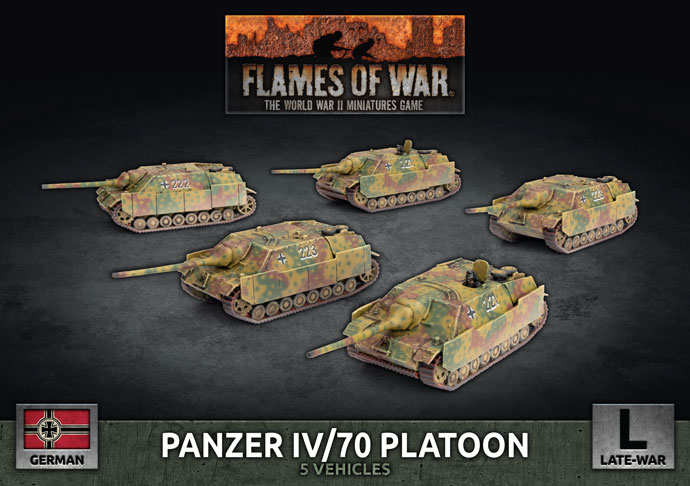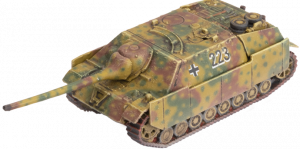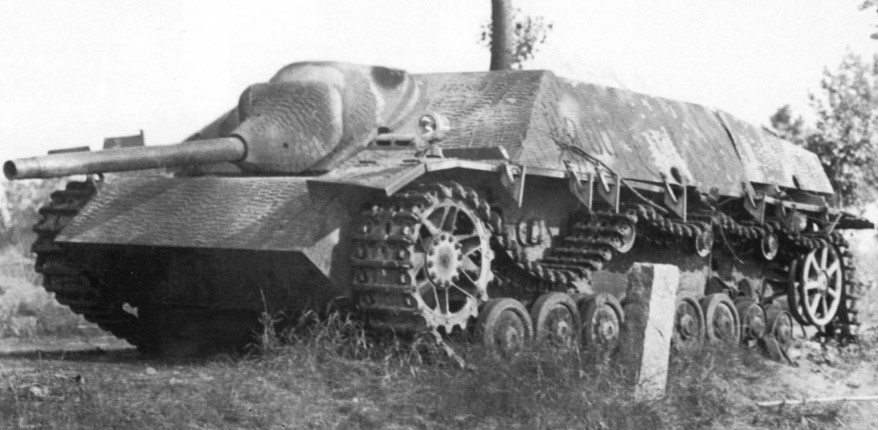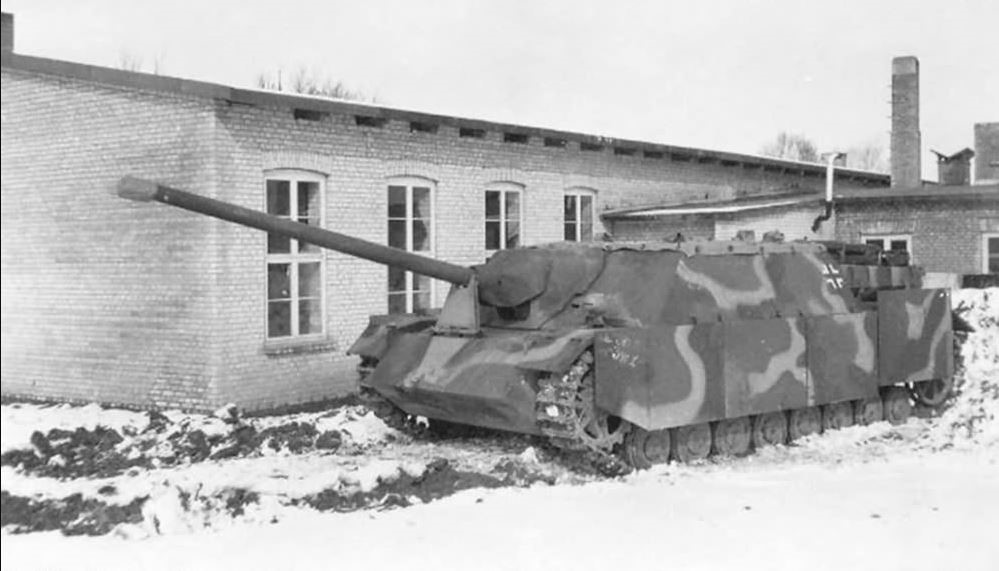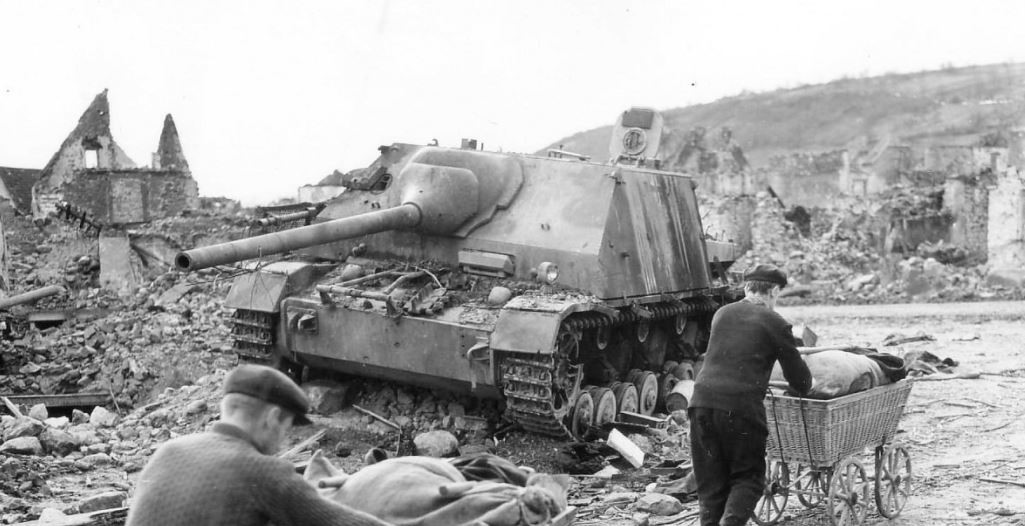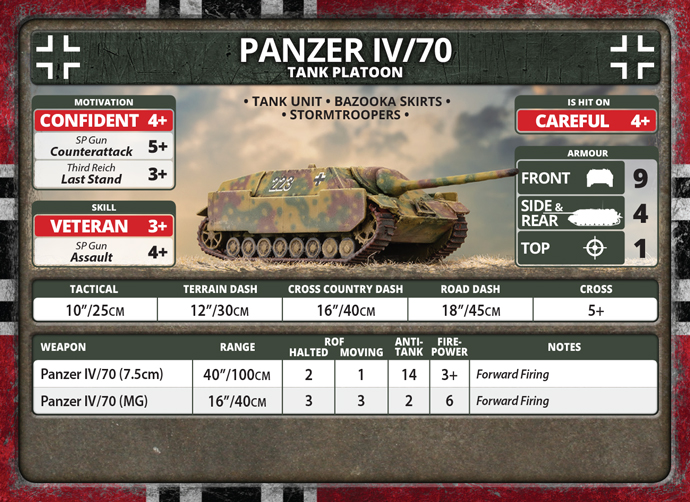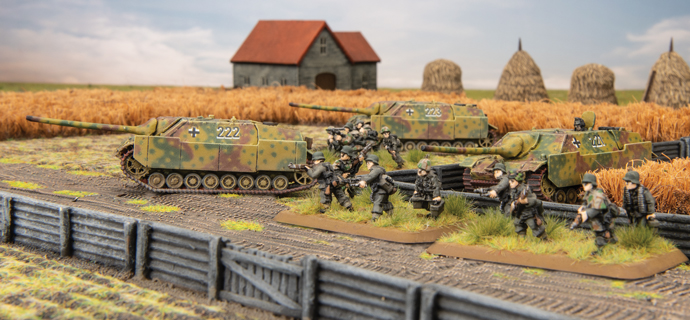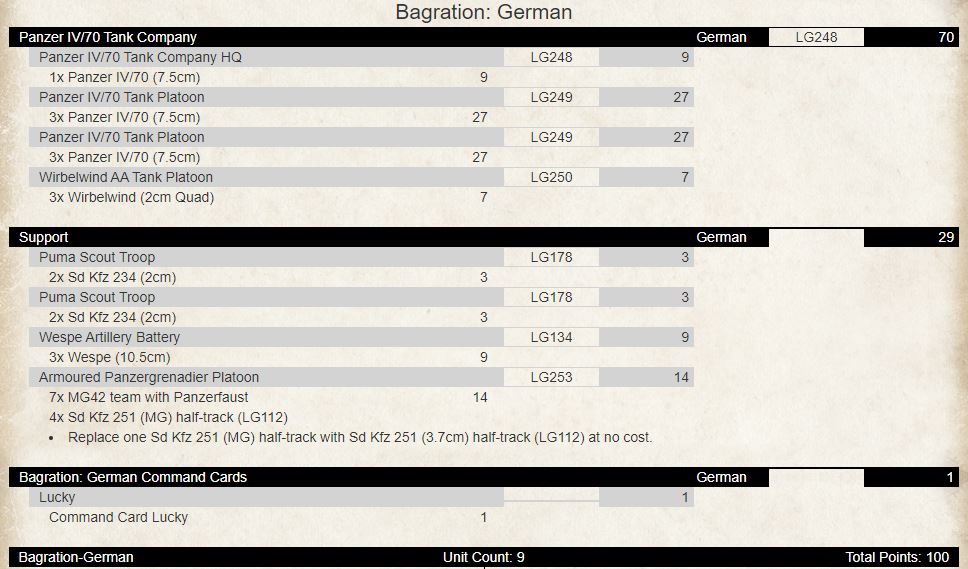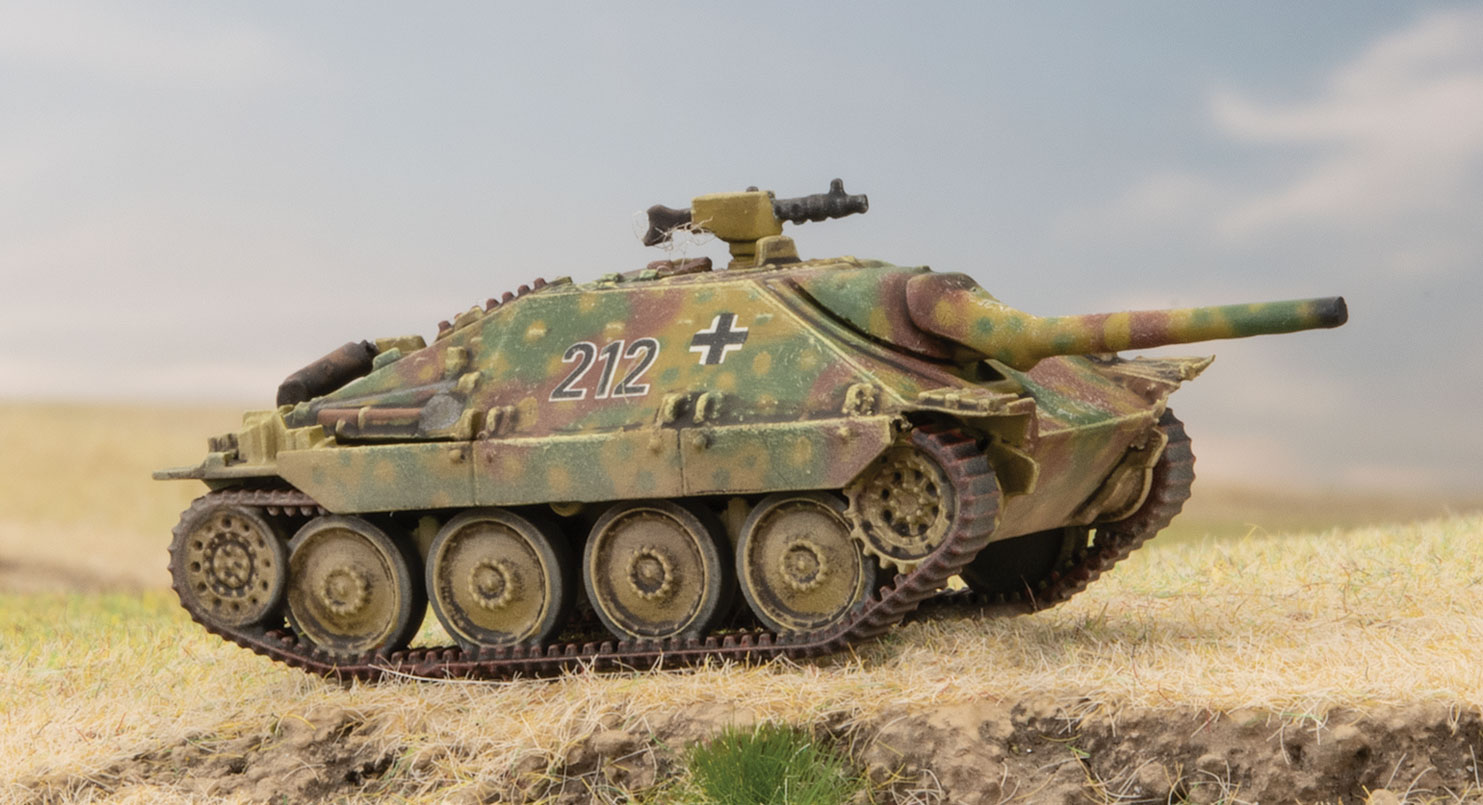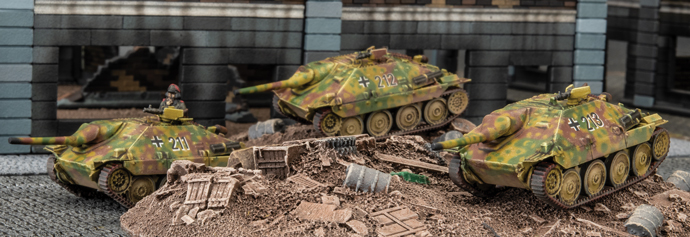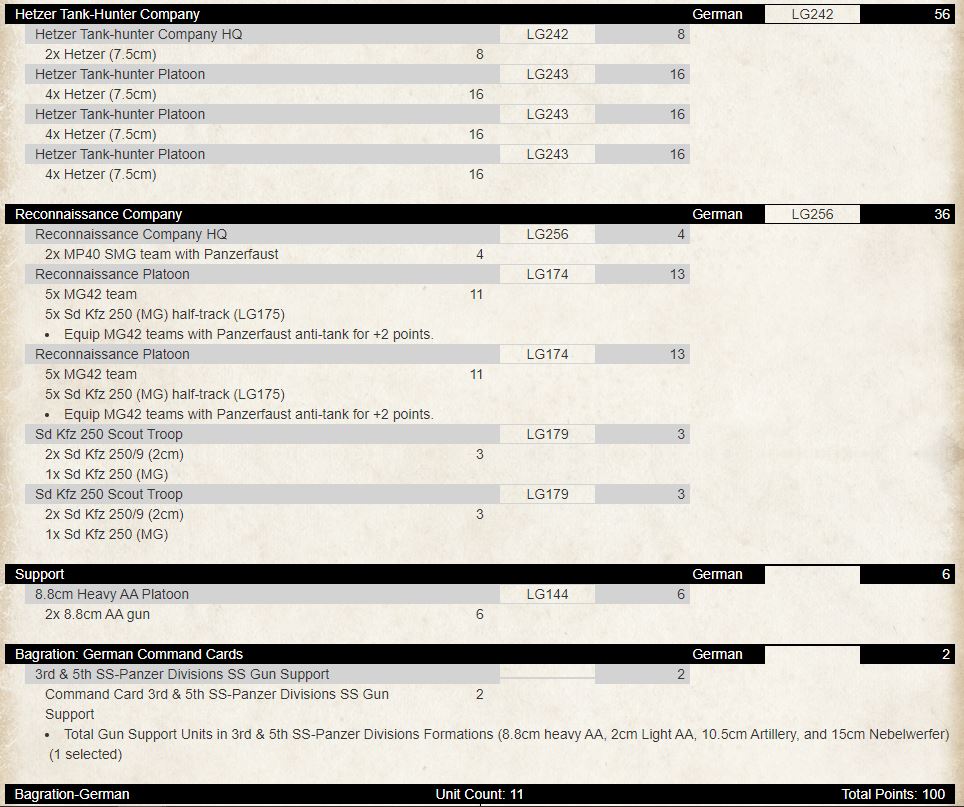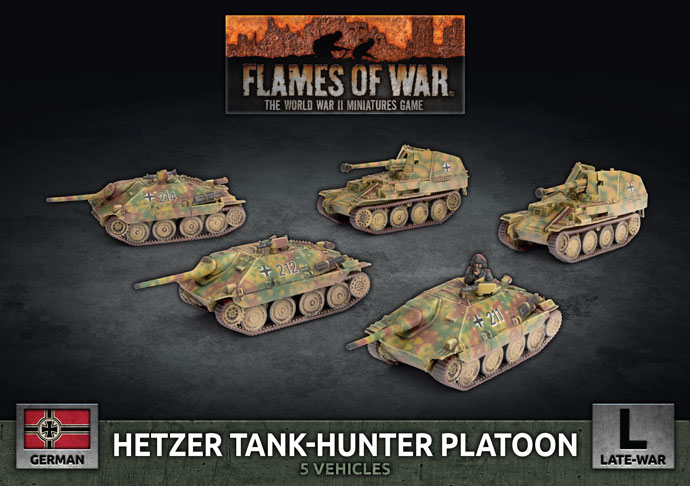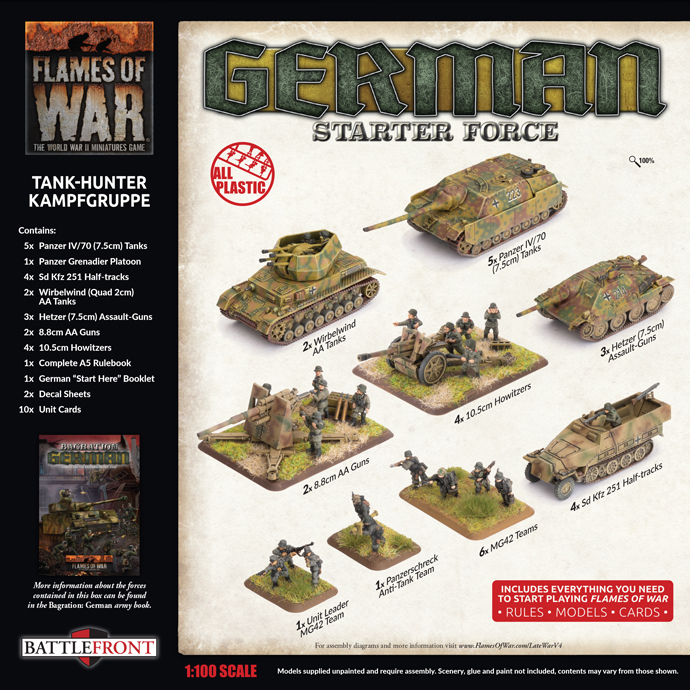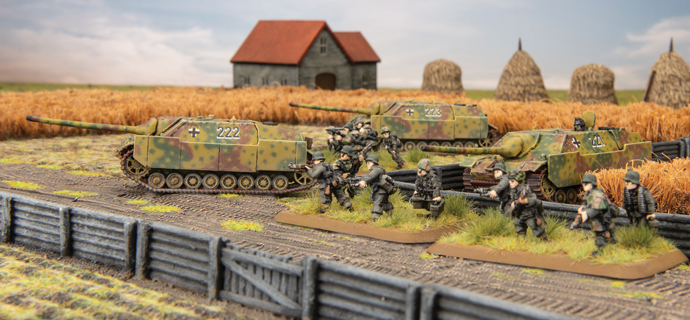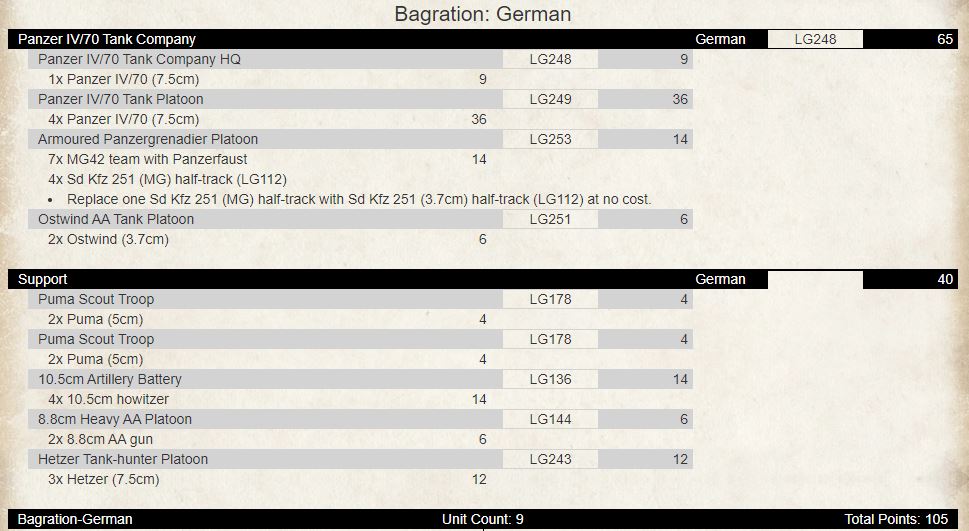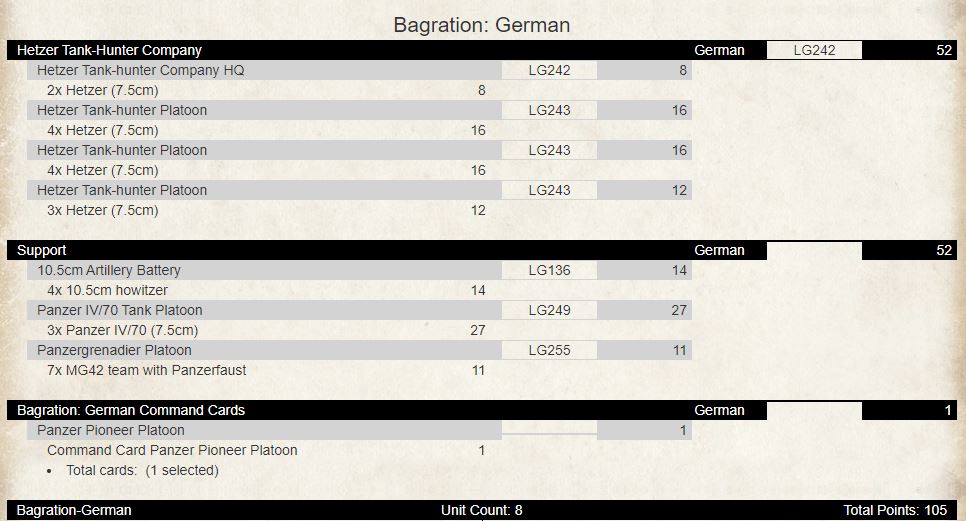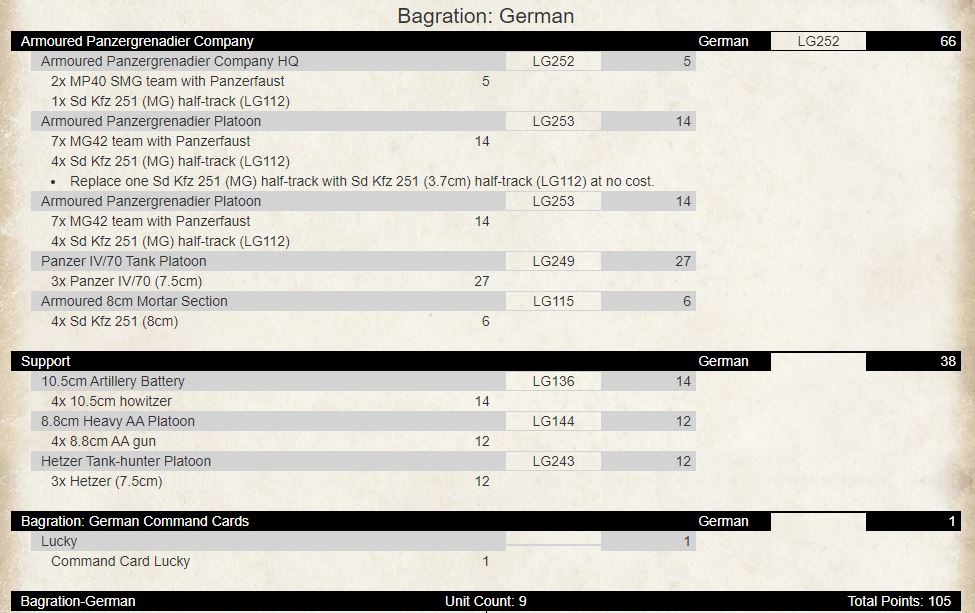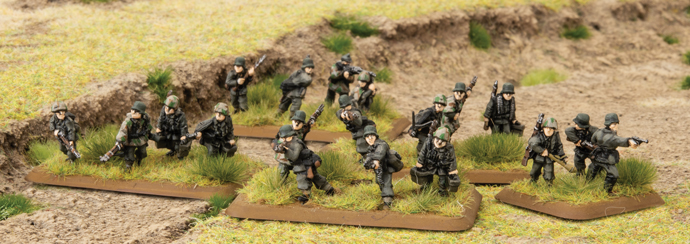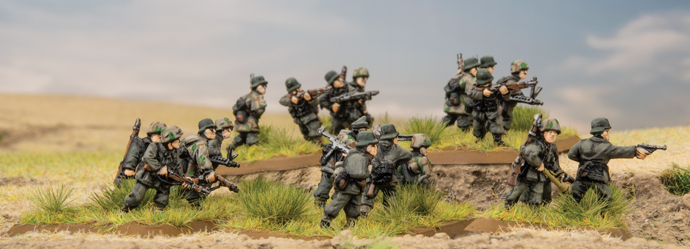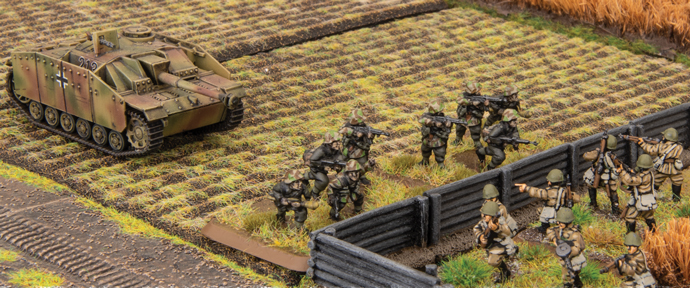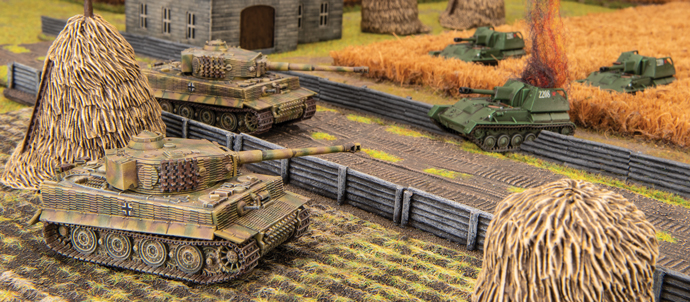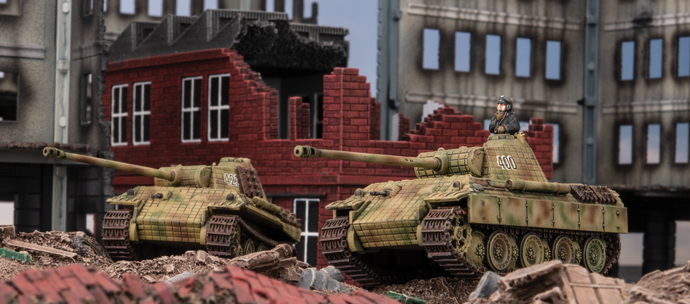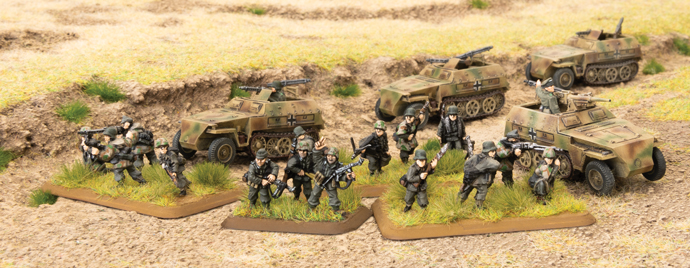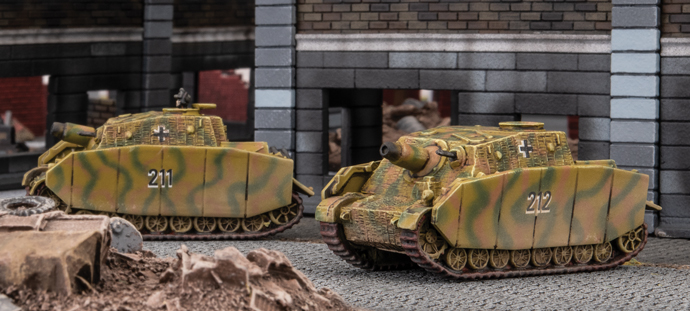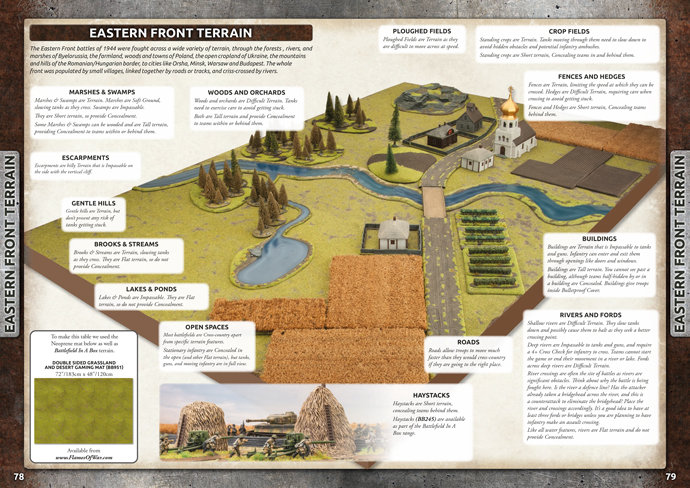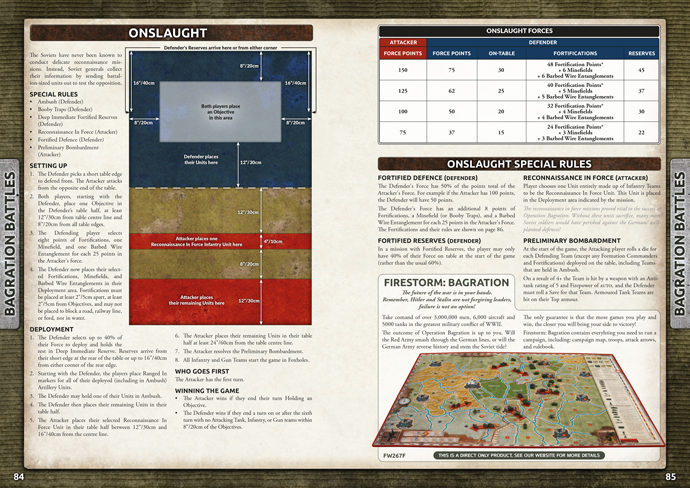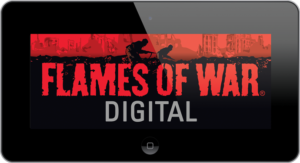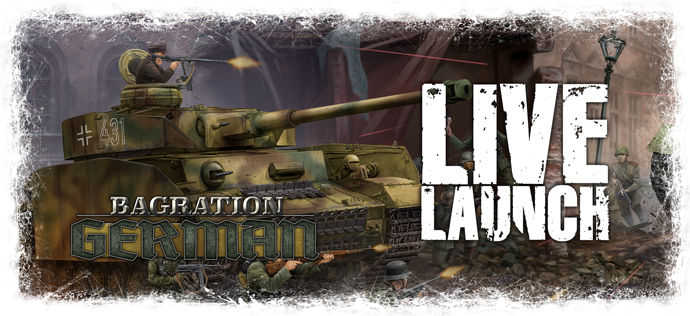Category: Bagration: German
Panzer IV/70 Tank Company – A Dangerous Duck
With Adam Brooker
The idea for the Panzer IV L/70, or Jagdpanzer IV/70, was for it to be the successor to the very successful Sturmgeschütz III (StuG III). The StuG III was an infantry assault gun that was initially designed and implemented to support infantry in assaulting dug in positions, but when pushed into the role of a tank destroyer proved very effective, due to its low profile and when upgraded with a 7.5cm StuK 40 L/43 and L/48 cannon, it could penetrate the T-34 and Sherman frontally at ranges in excess of 1000 meters.
In 1942 the initial specifications for the tank destroyer based on the Panzer IV chassis (to reduce the number of different vehicles being produced) as a casement-style turretless tank destroyer, with 100mm of armour frontally, with 40 to 50mm on the sides, and to mount the excellent 7.5cm L/70 gun that the Panther was using so successfully. It was also to have as low a profile as possible, similar to the StuG III previously, which was excellent for ambushes. VoMAG was successful in using an almost unaltered Panzer IV chassis in their design and it was accepted, with a mild steel version submitted for the Fuhrers approval in late 1943.
During the design phase it was found that 100mm frontal armour specified was not practical, so an angled 60mm of armour was used instead, and after about 300 vehicles were produced in May 1944, this was increased to 80mm of armour which gave approximately the same level of protection. The frontal armour was also made of interlocking plates welded together to also make production easier and faster.
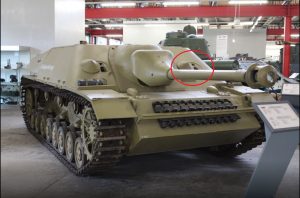
It was also noted that initially little or no consideration was given to how the extra weight of the much longer gun would affect the driving characteristics of the Panzer IV chassis, as Hitler had ordered it to go into production immediately and it seemed bad things happened to people who did not follow the Fuehrer’s demands immediately! (unreasonable or not…)
It had the effect of making the tank destroyer very nose heavy, especially when combined with the additional front armour that was also specified in the design. To further reduce this weight at the front, the spare track links which were originally stored at the front like the Panzer IV were moved to the rear. But overall this weight made them less mobile and very difficult to operate in rough terrain, and crews gave it the nickname “Guderian’s Duck”, poking fun at the General that was given a vehicle he did not want or felt was needed.
Heinz Guderian was the Inspector General of Armoured Troops at the time, and an early advocate of the Blitzkrieg style of warfare the Germans employed successfully in Poland, France, and Russia, and was very against yet another conversion of a successful design. He felt it diverted resources away from the production of the Panzer IV, and it was not needed, as the StuG III was doing a perfectly reasonable job at the time. Arguably at the time, 1942-1943 it was, but as the war progressed it started to struggle, as heavier Allied designs took the field.
Looking back at German tank production during WW2, it has been noted by many scholars that the Germans wasted a lot of resources and time on different variants and designs, based on successful chassis that could have been better spent on producing more of the proven designs, like the Panzer IV, Panther and StuG III.
The Allies had shown by producing tanks like the Sherman and T-34, with very little variation except for new turrets and up-gunning, that this often was not needed or warranted. But the Allies could afford to replace losses in tanks and manpower easily, where the Germans could not, and often had to do a lot with a little.
Additionally, with the increase on heavier Soviet designs on the Eastern Front like the T-34/85 and KV and IS tanks, and British Churchill tanks on Western Front, German designs like the Panzer IV and StuG III were lacking the penetrating power at the range and found that they needed to engage the enemy at closer and closer ranges to be successful.
The Germans needed, especially on the Eastern Front (where they were taking most of their losses and facing the bigger foe), to knock out Soviet tanks at the range, before the enemy tanks got into effective range themselves, to keep an effective kill ratio. So the L/70 gun on the Panther, on the large open battlefield of the Eastern Front, was perfect for this. So there is definitely a need for this type of tank destroyer on the Eastern Front, but probably not so much on the Western Front, where most tank engagements were short range firefights, more akin to a knife fight than the long range tank duels and mass charges of the Eastern Front.
So it is arguable that the Germans did need many of these variants they produced (except probably not vehicles like the King Tiger, Jagdtiger), given the different landscapes they were fighting in, but did not have the resources or manpower needed to be successful on the multiple fronts they were fighting on. The further the war dragged on, the more time the Allies had to wear down Germany, and with the Allied superiority in resources and manpower, draining the lifeblood of Hitler’s war machine, it was only a matter of time. But the Germans were aware of this, even at the start, which is why they needed to win in Europe quickly with their Blitzkrieg style warfare to not get bogged down in a prolonged multi-front war, which they knew they would probably lose….. Anyway, I digress….. Back to the Panzer IV/70.
The design was accepted and went into production immediately, but initially only fitted with the 7.5cm L/48 gun, as there was a shortage of 7.5cm L/70 guns, due to the priority on Panther production. Initially, about 800 were produced from Jan 1944 to November 1944 with the shorter L/48 guns with a muzzle brake, and are commonly referred to as Jagdpanzer IV, or just Jagdpanzer.
As you can see in many historical images, the muzzle brake was removed by crews in the field, as they found the dust clouds it kicked up after firing (due to the vehicle being so low to the ground), betrayed their position immediately, which would necessitate them re-positioning after only one shot. Later variants would all be produced without a muzzle brake. Later when the intended 7.5cm L/70 became available, two different variants of the Panzer IV/70 were produced, the Panzer IV/70 (V) and the Panzer IV/70 (A).
The Panzer IV/70 (V), with the V standing for VoMAG the manufacturer, with the longer barrelled 75mm Panther L/70 gun (that could outrange any allied weapon), was produced between August 1944 to April 1945, with about 940 manufactured. This was the most produced version, and VoMAG stopped producing any Panzer IV tanks at all, to concentrate entirely on the production of the Panzer IV/70. But it seemed initially
The other version produced with the 75mm L/70 gun was the Panzer IV/70 (A), this was made by Alkett, and was done to speed up the production of 75mm L/70 gun equipped vehicles to the front line, and not an interim design as some have speculated previously. Alkett normally made StuG III and Panzer IV tanks from its Nibelungenwerke Factory, it was ordered to quickly design and produce a 75mm L/70 armed tank destroyer on a standard Panzer IV chassis and not a modified chassis like the VoMAG design was, which allowed its very low silhouette. To do this required additional vertical steel plates be added to mount the L/70 gun on the standard chassis, this increased the height to 40cm, and it lacked the sharp nose of the VoMAG variant. Around 278 were built at Nibelungenwerkefrom from August 1944 to March 1945.
Originally the plan was for all Panzer IV tank production to stop and to focus on Panzer IV/70 production, but this never happened. The dire need for vehicles on both fronts, and delays in vehicle production that this would necessitate and that the turreted Panzer IV was still a very good tank and had advantages that a hull mounted tank destroyer did not all played into this decision. If this had happened, I think it would have only made the situation worse for the Germans.
In combat, when given to experienced crews, they performed well. In November 1944 Panzer-Regiment 2. was given 11 Panzer IV/70 (A) to replace losses to their Panzer Companies, and during fighting in the Colmar Pocket they reported the loss of 3 tank destroyers, but at the cost of 50 enemy tanks.
They fought on both the Eastern and Western Fronts, as replacements to Panzer Divisions and Tank Hunter Battalions, often as part of mixed companies, fighting alongside, StuG’s, Panzer IV’s, and Panthers. They were noted especially in the Fuhrer Begleit Brigades fighting in the Ardennes and in the defence of Budapest in Hungary. They were also in the Schwere Panzerjager Abteilung 655 which included Jagdpanthers, StuG III, Hornisse, and Panzer IV/70s, but they were often broken up into different companies and spread out to try to make the most of their firepower. They were also given to SS Panzerjager Battalions and fought on both Fronts depending on where the parent SS Division was located at the time. It appears that most of the vehicles produced in 1944 went to the western front, but from Jan 1945 onwards with the Soviets smashing the German defences in the Bagration Offensive, the East became the priority. As a side note, the practice of putting zimmerit on vehicles was stopped by September 1944, so any vehicles produced after that were produced without the time-consuming process of the nonmagnetic covering.
Overall their combat effectiveness was mixed. When used in their proscribed role, of a tank destroyer, they performed well. Their low profile, good armour protection, and excellent gun allowed them to effectively ambush enemy tanks at ranges that their targets could not reply from. But when forced into the role of a tank or infantry assault gun, they did not, mostly due to their poor handling in difficult terrain ( due to their nose heavy design) and lack of a turret. This was happening more and more in the war’s later stages, as they were used to replace mounting losses.
One notable Panzer IV/70 ace was Rudolf Roy, who was attached to 12th SS Division Panzerjager Abteilung and died fighting in the Ardennes offensive. In the Normandy fighting his Panzerjager 39 was defending Hill 111 near Soignolles, Normandy, against the Polish 1st Armoured Division. You can find his Command Card in the German D-Day Waffen SS Command card pack, in that card he is fielded in a Jagdpanzer 7.5cm L/48, not a Panzer IV/70, but still is good to see he is represented.
He personally knocked out 9 Polish Shermans and stalled the Allied advance to allow the Germans to retreat successfully that evening. The Polish attacked again that night, with a surprise thrust in the middle of their Kampfgruppe, and he again led his Panzerjager, and on his own initiative, flanked the attacking 15 Polish Shermans, knocking out another 4 personally, with only 2 Shermans from the 15 escaping intact. In the fighting withdrawal over the next 5 days, he knocked out a total of 26 tanks, and earning himself an Iron Cross, with his total at the time of his death approximately 36 British and Soviet Tanks. He was eventually killed in the Ardennes Offensive when his unit was attacking the US 99th Infantry Division, and he was shot by a sniper while looking out his panzer’s hatch during an assault.
Enough about history, how do these Panzers play in game? Well, their FA of 9 is excellent, just as good as a Tiger or Panther, with essentially the same gun as the Tiger and Panther too!! So frontally it can take a hit and dish one out, and it’s 2 points cheaper than a Panther and 3 points cheaper than a Tiger… so what’s not to love??
Well, its downside is its lack of turret and its low side armour of 4, which means it really does not want to be flanked, as unless it does a blitz on 3+, it will have to move to fire, which lowers its RoF to 1, and that assumes it survived the flanking shot… Also, it does not want to be assaulted as it’s a self propelled gun, so has the usual penalties in Assault and Counter-attacking. On the plus side, it does have an MG to protect against infantry, but it is forward firing as well, so make sure you are facing any infantry close enough to assault you, or you are a dead duck!! Also, beware of any cross tests you need to make, a 5+ means you will most likely fail…
But if you use them in their intended role, as long-range and even better ambushing tank destroyers, you can’t go wrong. Their 4+ to hit, especially if you are at long range and concealed, combined with your FA 9, will mean you are very hard to kill. But I would suggest not ambushing from a forest unless they either won’t need to move much or have something to protect or dissuade infantry assault, as they will not be moving out of that difficult ground quickly.
I think these will work best as either a support unit of 3 or 4, as dedicated tank destroyers and ambushers in an infantry force, or as part of the German Bagration Tank Company with Panzer IVs, where they can act as the big guns in your list and the Panzer IV as your jack of all trades.
But they can also work as their own Panzer IV/70 Company, I have made up a list below, that while not an easy list to play, can do well in the right hands. Make sure to use the Pumas to expand your deployment zone if possible, but don’t be too cavalier with them either, their role is to annoy, not to hunt tanks. But I do enjoy gunning down self propelled infantry with them… I also like the weight of fire the Wirbelwinds can add, and the new kits for them look awesome. The armoured Panzergrenadiers also allow you to counter-attack your opponent’s objective quickly as well, and the hail of MGs they can spit out is impressive as well!
Well, I hope you have found this as interesting as I did, and you grab a box of these “Flat Panzers” to add to your forces. I used to enjoy running a company of these in older versions, and the cut-price Panthers did well for themselves then too, and I’m sure they will now as well.
Ambush Predator: The Hetzer in Flames of War
With Joe Saunders
As world War II dragged on, the Axis found themselves in a dire situation. As momentum on the Eastern Front ceased at Stalingrad and Kursk, it became apparent that they lacked the production capacity to hold the Red Army back (and eventually rebuff the Allied landings in Normandy in 1944). Worse still, military innovation was progressing at a massive pace, but the realities of shortages of raw materials and manpower meant that to keep up with the Allies, Germany had to do more with less. And for a time, they achieved this, though in limited terms. Advances in cheap portable shaped charge weapons enabled infantry to destroy heavy tanks and dedication to quality over quantity led to some truly impressive (If somewhat impractical) late war behemoths like the Tiger II. But numbers have a role to play in warfare and the Axis knew they also needed a new tank destroyer in large numbers. This weapon needed to be both easy to produce with minimal resources and armed with a weapon fearsome enough to deal with anything the Allies could field. This tough task was achieved by putting a large, but commonly available, gun on the small frame of the numerous, yet obsolete, (modified) Panzer 38T. The resulting vehicle became known as the Hetzer.
The Hetzer in Flames of War
For the German Flames of War player, the Hetzer, which is featured in the new army book Bagration: German represents an opportunity to bring a decent gun to the fight without breaking the bank on points. Traditionally the Axis player has paid a premium for their tank destroyers, owed to the general German trend for having high-quality weapons, good armour, and excellent Skill and To Hit On ratings. The Hetzer reverses this course by balancing armour and firepower with economy. Despite this, the Hetzer has stats that appear on par with the StuG III, a much loved and flexible option for German players. These two vehicles have the same Skill and Hit On ratings. Also, the StuG and Hetzer are at parity with their close combat stats with a counter attack and assault of 5+ (which is fitting for a vehicle designed to stand off from the enemy). The armour is the same. They both feature Front Armour 7, which is excellent, and mediocre Side 3, Top 1 values. Lastly the gun is the same, a forward firing 7.5cm with AT11, 2 shots when stationery, 1 on the move and 3+ Firepower (a canon that even in late war most Allied tankers wish they had). But this brings us to the one really important difference that makes the Hetzer worth 4 points compared to the StuG’s 5.6 points; The Hetzer is overworked. If you are unfamiliar with this rule it means the Hetzer has an extra +1 to hit when it moves.
Tactics For The Hetzer
The Ambush:
Considering the overworked rule provides a 1.6-point discount for the Hetzer, (over the Stug) you come away with a pretty good trade-off in my opinion. However, this does require the German Player to rethink his play style. With Front Armour 7 the Hetzer can take the odd hit, but if it is going to go toe to toe with the enemy’s heavy hitters and earn its points, it is going to need to use some tricks. First and foremost, the Hetzer was designed to ambush its opponents, so in Flames of War, when you are playing a scenario where you can use Ambush rules, the Hetzer is your best option. Once you spring your ambush each Hetzer in the platoon will have its 2 shots without the penalty from being Overworked (because they count as stationary when they spring the ambush). If you have to place the ambush in a vulnerable spot you do not have to worry too much. At 4 points each, you can likely get a pretty good trade-off in point returns from destroyed enemy teams before your Hetzers are taken out by return fire.
Storm Troopers:
If you are an experienced German Flames of War player the Blitz/Shoot and Scoot combo is likely not new to you, and the Hetzer is practically made for this. With this tactic, you use the Stormtroopers rule to Blitz your Hetzers from behind terrain that blocks line of sight (like a building or hill) so they count as stationery in the shooting phase thereby avoiding the overworked penalty. Then after they fire 2 shots each, you Shoot and Scoot them back into cover so in the following turn the enemy cannot shoot back. Most German players will have used this tactic with other vehicles at some point. The German’s excellent 3+ Skill makes this combo possible…usually. As you have to be successful on both Skill roles to pull this off, most Axis players can probably think of a time when their precious and expensive panzers failed their subsequent roll leaving the entire unit exposed to a platoon of M10 Achilles or other scary anti-tank units. (Then this platoon subsequently annihilates your exposed tanks in the next round.) The Hetzer however is the answer to this problem. The Hetzer has the 3+ Skill to pull off the Blitz/Shoot and Scoot combo, but if it fails the Shoot and Scoot roll it’s no big deal. If they end your turn in plain sight of the enemy’s return fire, you don’t risk losing much. 3 Hetzers is 12 points, where a single Tiger is 12 points. This means you should be able to absorb the return fire, and if you lose the whole platoon, it is not likely to be as disruptive to your battle plans as seeing your Panthers or Tigers burst into flames.
Hetzer Horde
Where the above tactics are variations on exiting techniques in Flames of War, this one is new. Rather than using Hetzers as support to help your army, you can use the Hetzers as the army! Just go ahead and max out every option to take this little tank hunter in your force. 14 Hetzers will run you only 56 points. Here is an example of a Hetzer based force I have been thinking about:
With this list, you can use the Scout half-tracks to spearhead your Hetzers deep onto the board (and hopefully on the flanks). The reconnaissance infantry/half-track troops can stay close to provide infantry support and the 88s can sit back to deal with more formidable armour and guard objectives. I think this list would be quite fun to play as you come at your opponent from many different directions to overwhelm them with a bunch of small tanks.
Time to Set the Ambush
However, you choose to use the Hetzer I think Bagration German has brought us a cool new addition to the Axis arsenal in Flames of War. Whether you keep them in Ambush, pull the Stormtrooper combo on your enemy, or flood the board with numerous tank destroyers, the Hetzer promises to become a regular feature in the game. So, get out your paint and glue and get ready to add this new weapon of war to your force and show the Allies that when it comes to German tank destroyers it really is possible to effectively do more with less!
Building A Bagration German Forces with the Tank-hunter Kampgruppe Starter Box
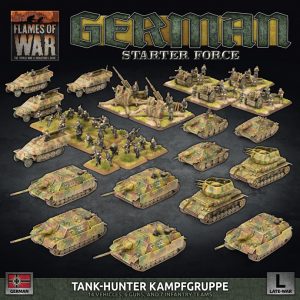
With the launch of the Bagration: German release, I thought I would look at how a new player, or someone on a budget, get a force on the table that would be semi-competitive or at least hold its own with such iconic equipment as the Hetzer assault guns and Panzer IV/70s. For the new player, it opens the door to playing Flames of War without needing to buy, assemble or paint too much and get into playing the game quicker.
So, if we look at what we get in the excellent value starter set (Tank-Hunter Kampfgruppe), that will help decide what formation to run. The starter set contains the following:
- Complete A5 Rulebook
- German “Start Here” booklet
- 5 x Panzer IV/70 Tanks or Jagdpanzer IVs
- 3 x Hetzer Assault Guns or Marder 3s
- 1 x Panzer Grenadier Platoon
- 4 x Sd Kfz 251 Half-tracks
- 2 x Wirbelwind or Ostwind AA Tanks
- 4 x 10.5cm Howitzers
- 2 x 8.8cm Heavy AA Guns
- 2 x Decal Sheets
- 10 x Unit Cards
The bonus here is that the rulebook is included in the box – so the new player makes a saving right away. Now if we look at what formations are in the Bagration: German book, we can see what we can maximize from what we get in the starter box. The most obvious formation is the Panzer IV/70 Tank Company. There are now three German Late War Starter boxes in total so we will explore what options we can have with multiple starter boxes. We will look at two points options – the 2021 points for LW (105pts) and the standard 100 pts. Might not be much in it, but it can decide how to structure your force.
Starting with just the single starter box by itself, we will look at the Panzer IV/70 formation first followed by the Hetzer formation. Let us look at what units comprise this formation:
- 1 Panzer IV/70 Tank Company HQ
- 1-2 Panzer IV/70 Tank Platoon
- 0-1 Panzer IV/70 Tank Platoon or Panther Tank Platoon or Tiger Tank Platoon or Armoured Panzergrenadier Platoon
- 0-1 Wirbelwind AA Tank Platoon or Ostwind AA Tank Platoon or Mobelwagon AA Tank Platoon or Sd Kfz 7/1 Quad AA Platoon
Looking at the formation and what we get in the starter box, we can maximise the Panzer IV/70s, Panzer grenadiers with their half-tracks and the AA tanks. The Hetzers could be used as formation support with the 10.5cm Howitzers and 8.8cm AA guns in support.
This formation is a bit fragile but if handled well, should perform OK. It only has four units for the formation break and four small platoons of 2 teams. This is primarily a defensive force but can have a bit of fun with two platoons of Pumas causing havoc and you can put the four Panzer iv/70s in ambush. Now for 5pts less, you could remove one of the Puma Scout Troops, downgrade the two Ostwinds to Wirbelwinds and pick up a Lucky Command Card.
To buy this army you need only to purchase the following for $170:
| 1 x GEAB20 German “Tank-Hunter Kampfgruppe” Army Deal | $110 |
| 1 x GBX172 Puma Scout Troop (Plastic) | $40 |
| 1 x FW267 Bagration: German: A4 Hardback | $20 |
| Total: | $170 |
The second formation we can look at is the Hetzer formation. Let us look at what units comprise the formation:
- 1 Hetzer Tank-Hunter Company HQ
- 2-3 Hetzer Tank-Hunter Tank Platoon
As we only get three Hetzers in the starter box we need to add a couple of boxes of Hetzers to make this formation complete, but we can use the rest of the starter box to flesh out a decent list.
You could also remove two Hetzers and the command card if you wanted a fourth Panzer IV/70. To make this 100pts just drop one more Hetzer from one of the two full platoons and the command card for the Panzergrenadiers.
To buy this army you need only to purchase the following for $230:
1 x GEAB20 German “Tank-Hunter Kampfgruppe” Army Deal$1101 x GBX172 Puma Scout Troop (Plastic)$401 x FW267 Bagration: German: A4 Hardback$20Total:$170
| 1 x GEAB20 German “Tank-Hunter Kampfgruppe” Army Deal | $110 |
| 2 x GBX167 Hetzer Tank-hunter Platoon (Plastic) | $100 |
| 1 x FW267 Bagration: German: A4 Hardback | $20 |
| Total: | $230 |
I think the best value for this starter box is when combined with one of the other two German starter boxes. If we combined it with the German Panzer Kampgruppe Army Deal, we get the additional models:
- 5 x Panzer IV Tanks
- 2 x Tiger Tanks
- 3 x Stug Assault Guns
- 1 x Panzer Grenadier Platoon
- 4 x Sd Kfz 251 Half-tracks
- 3 x 15cm Nebelwerfer Rocket Launchers
- 2 x 8.8cm Heavy AA Guns (doubling our 8.8cm Heavy AA Guns)
Now to my eyes, this gives a great start to run different formations by adding further boxes as required, but the best formation to start out with, combining both starter boxes is to run an Armoured Panzergrenadier Company. This formation comprises the following units:
- 1 Armoured Panzergrenadier Company HQ
- 1 Armoured Panzergrenadier Platoon
- 0-1 Armoured Panzergrenadier Platoon or Panzergrenadier Platoon or Reconnaissance Platoon
- 0-1 Armoured Panzergrenadier Platoon or Panther Tank Platoon or Panzer IV Tank Platoon or Stug Tank Platoon or Panzer IV/70 Tank Platoon
- 0-1 Armoured 8cm Mortar Section
- 0-1 Armoured 7.5cm Gun Platoon
- 0-1 Grille 15cm Gun Platoon or 15cm Gun Platoon
- 0-1 Armoured sMG34 Machine-Gun Platoon
- 0-1 7.5cm Tank-Hunter Platoon
- 0-1 Sd Kfz 10/4 Light AA Platoon
That is right – we can have our Panzer IV/70s integral to the formation! To maximise the two starter boxes for this formation we need to buy an Armoured HQ box and a box of Gun/Mortar half-tracks as well. So how does this look for 105pts?
Pretty solid formation and has two artillery templates – one of which is integral to the formation. If you prefer the 7.5cm Gun Half-Tracks you can swap them in for the 8cm Mortar Half Tracks for the same points cost. You can swap out the Panzer IV/70s for the Tigers or Panzer IVs or Stugs – or add what you prefer as formation support. To get to 100pts, swap out the 1.5cm Artillery Battery for 15cm Nebelwerfers for 5pts difference exactly.
To buy this army you need to purchase the following for $295:
| 1 x GEAB20 German “Tank-Hunter Kampfgruppe” Army Deal | $110 |
| 1 x GEAB18 German Panzer Kampgruppe Army Deal | $110 |
| 1 x GBX168 Armoured Panzergrenadier Company HQ (plastic) | $15 |
| 1 x GBX177 Gun Platoon / Mortar Section (x4 Plastic) | $40 |
| 1 x FW267 Bagration: German: A4 Hardback | $20 |
| Total: | $295 |
The other formation you could run that is like the above is the Panzergrenadier Company. It is basically the same except for the HQ, mandatory platoon of Panzergrenadiers instead of Armoured Panzergrenadiers, 8cm Mortars instead of Armoured 8cm Mortars and you can choose between Armoured 7.5cm Guns, 7.5cm Guns or 12cm Mortars.
There you have it – some options to ponder for getting started with different formations with the starter box(es). Enjoy!
Bagration: German Spotlight
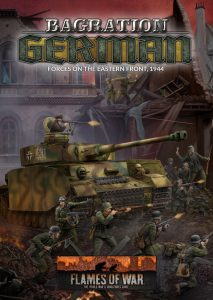
Bagration: German is the third German-themed book in the Flames Of War Late-war series of army handbooks (after D-Day: German and D-Day: Waffen-SS). It is also the second of the Bagration series, bringing you German Eastern Front forces fighting against Soviet Operation Bagration as featured in Bagration: Soviet.
Bagration: German covers the German forces fighting all across the Eastern Front from Finland in the north to Romania and Hungary in the south from January 1944 to January 1945.
There is a great variety of formations and units available to field, from tanks and armoured infantry to grenadiers and tank-hunters.
Check out Bagration German in the online store here…
Grenadier Company
The first formation you will encounter is the Grenadier Company. These are hardened Eastern Front veterans with the full array of support weapons including machine-guns, 8cm and 12cm mortars, 5cm and 7.5cm anti-tank guns, 7.5cm and 15cm infantry guns, anti-aircraft guns, and scouts.
These confident troops also have Third Reich, giving them Last Stand 3+. They are Veterans so they pass Skill related Movement Orders on a 3+ and Hit On 3+ in Assaults. The teams of the Grenadier Platoons are armed with Panzerfausts (Limit 1), allowing them to use one team each Shooting and Assault step as a Panzerfaust anti-tank weapon.
Storm Grenadier Company
If you like the sound of the veteran Grenadiers, you can go one step further and take the Storm Grenadiers of the 78th Sturm Division. These troops have a support listed above, but with twice as many 7.5cm anti-tank guns and machine-gun platoons. The Storm Grenadier Platoons themselves are the same ratings as the Grenadiers, but have twice as many MG42 machine-guns in their platoons making them MG42 teams with Rate of Fire 3 stationary and 2 while moving. Like the Grenadiers the Storm Grenadiers are automatically equipped with Panzerfaust (Limit 1).
StuG Assault Gun Battery
The 78th Sturm Division had its own assault gun battery permanently attached to the divisions, the 89th Assault Gun Battalion. As well as being equipped with both StuG (7.5cm) and StuH (10.5cm) assault guns, the battalion also had its own tank escorts, or tank riders, to protect them from enemy infantry. These troops are armed with new StG44 assault rifles. Assault rifles have a longer range than SMGs, but similar firepower, so when combined with the assault guns own machine-guns, are able to keep any aggressive infantry at bay.
So keep an eye out for these new tank escort StG44 assault rifle-armed infantry, one of the many new releases coming out for Bagration: German:
Other assault gun battalions also fielded tanks escorts, as well as becoming semi-attached to particular divisions, so this formation is not exclusively representing the 78th Sturm Division.
Hetzer Tank-hunter Company
A very common tank-hunter to begin making its appearance on the Eastern Front during 1944 was the Hetzer. This tiny ball of power is armed with the same gun as the StuG but based on widened Czech Panzer 38(t) tank chassis. It has the same level of protection as the StuG. However, it is overworked due to the position of the gun and the general lack of space in the fighting compartment. As a tank-hunter its primary role is ambushing enemy tanks so does need to be rushing about the battlefield.
The Hetzer will come out as a new plastic kit which will make the Hetzer tank-hunter, as well as the Marder tank-hunter (the Marder III M, for us rivet counters).
Tiger Tank Company
To represent the Tigers fighting on the East, we have also included a Tiger Tank Company. You field up to three Tiger Tank Platoons and one of four different anti-aircraft options (more about those further down).
Panther Tank Company
With the Bagration Panther Tank Company, we have introduced a few additional options over the ones found in D-Day: German. Your second black box unit can be chosen from five different options; Panther Tank Platoon, Panzer IV Tank Platoon, Panzer IV/70 Tank Platoon, Tiger Tank Platoon, or an Armoured Panzergrenadier Platoon. This combined with the other one to two Panther Tank Platoons and the AA Tank Platoon options lets you create a battle group feel to your force
Panzer IV Tank Company
The Panzer IV formation lets you do something similar with the second black box letting you select from Panzer IV Tank Platoon, StuG Tank Platoon, Panther Tank Platoon, Tiger Tank Platoon, or an Armoured Panzergrenadier Platoon. While the Panzer IV formation lets you have one to three additional Panzer IV Tank Platoons.
Panzer IV/70 Tank Company
Late 1944 saw the widespread introduction of the Panzer IV/70 tank/tank-hunter. This low-slung assault gun is a development of the Jagdpanzer IV tank-hunter and was often issued straight to tank battalions. It has thick armour and the gun of the Panther tanks, making it rather nose heavy impeding its ability to deal with tough terrain.
This is another new plastic kit coming out with the release of Bagration: German. It will also allow you to make the Jagdpanzer IV tank-hunter.
AA Tanks
All of the above tank companies will also be able to field the new Wirbelwind and Ostwind AA tanks. Of course, you will still be able to field the already available Möbelwagen AA tank, as well as the Sd Kfz 7/1 Quad AA half-track.
The Wirbelwind and Ostwind AA tanks are also new plastic kits. You can build either of these kits as it comes with a turret frame letting you build both turrets. These fit on the plastic Panzer IV hull that also comes with the kit.
Armoured Panzergrenadier Company
Representing the infantry of the panzer divisions you will find several options in Bagration: German. The first of these is the Armoured Panzergrenadier Company representing the armoured half-track mounted infantry of the panzer grenadier regiment. Keeping with our battle group theme you can take a tank unit instead of a Panzergrenadier Platoon as your first grey box option being either: Panther Tank Platoon, Panzer IV Tank Platoon, StuG Tank Platoon, or Panzer IV/70 Tank Platoon. On top of the main infantry options, the formation can also take a variety of half-track mounted weapons including 8cm mortars, 7.5cm guns, and Flame-throwers, as well as towed or self-propelled 15cm infantry guns, 7.5cm anti-tank guns, and anti-aircraft.
Panzergrenadier Company
The bulk of the panzer grenadier infantry in a panzer division was mounted in motorised transports for travel but fighting on foot when the enemy was engaged. However, as the battles to hold back the Soviets intensified all along the front they were often grouped with tanks for fighting. With a Bagration Panzergrenadier Company, you can field tanks as part of your formation taking a Panther Tank Platoon, Panzer IV Tank Platoon, StuG Tank Platoon, or Panzer IV/70 Tank Platoon instead of your third Panzergrenadier Platoon. Though slightly less numerous than in the Armoured Panzergrenadier Company, the formation can take a number of armoured half-tracks mounted weapons as well as towed guns and weapons.
Reconnaissance Company
The bulk of the panzer grenadier infantry in a panzer division was mounted in motorised transports for travel but fighting on foot when the enemy was engaged. However, as the battles to hold back the Soviets intensified all along the front they were often grouped with tanks for fighting. With a Bagration Panzergrenadier Company you can field tanks as part of your formation taking a Panther Tank Platoon, Panzer IV Tank Platoon, StuG Tank Platoon, or Panzer IV/70 Tank Platoon instead of your third Panzergrenadier Platoon. Though slightly less numerous than in the Armoured Panzergrenadier Company, the formation can take a number of armoured half-track mounted weapons as well as towed guns and weapons.
Support
As mentioned above, support includes both the Marder Tank-hunter Platoon and the Jagdpanzer IV Tank-hunter Platoon, both now available as plastic kits.
For heavier self-propelled tank-hunting capabilities you can take either the Elephant Tank-hunter Platoon, of the Hornisse Tank-hunter Platoon. Both are armed with the powerful long 8.8cm anti-tank gun. The Hornisse is on a lighter chassis with just 2 front armour, while the Elephant is heavily armoured with front armour 16!
You can also field the 8.8cm Tank-hunter Platoon with the 8.8cm gun (Pak43). This has AT17, allowing it to knock out almost any tank.
If you are looking for a multipurpose gun that can know out tanks as well and aircraft you can always go for the 8.8cm Heavy AA Platoon with its AT14 and Self-defence AA abilities.Both of these guns are available as plastic kits.
There are plenty of choices for artillery, with the Wespe, Hummel, and 10.cm Artillery Batteries. If you like to make a bigger splash on the table you could also go for the Salvo template bombardments of the 15cm Nebelwerfer Battery or the Panzerwerfer 42 Battery. These rocket launchers saturate a large area with their rockets, hitting it with a 10”/25cm x 10”/25cm bombardment delivering Firepower 4+. The Panzerwerfer 42 provides mobility for relocating as well as providing armoured protection against light weapons. The Panzerwerfer 42 is a new model for Bagration: German.
Other support includes both Panzer III OP and Sd Kfz 250 OP Observation Posts, a Brummbär Assault Tank Platoon, anti-aircraft platoons, and Ju 87 Stuka Dive Bomber and Tank-hunter Flights.
Painting, Basing, and Terrain Guides
The book also contains colour guides for painting your models, guides for basing your infantry and guns, and a table guide to Eastern Front terrain.
Campaign and Missions
In the Bagration Fortified City Battles section, we introduced a Linked campaign using the Missions in the book as well as some form the Flames of War rulebook.
The Missions include a Fortified Defence Mission called Onslaught that uses Bunkers, Nests, Barbed Wire, and Minefields. The second Mission, Hammering the Line, has the defender less prepared with their flanks threatened. The final Mission sees the defend withdrawing ahead of the enemy attack, delaying them long enough to move back to their next defensive line.
All these Missions and the card fortifications needed to play Onslaught are all available in the River Assault Terrain Pack. Also available is The Race for Minsk Campaign, a narrative-driven system where players get to create their own heroes and fight on the marches of Eastern Europe and beyond.
The back of the book contains a comprehensive catalogue highlighting all the packs you need to field a force from Bagration: German.
Whether you are already playing a German Force, or just beginning, I’m sure there is something inside Bagration: German for you.
So pick one up at your friendly local gaming store.
Bagration: German Live On Forces and Digital
Bagration: German is live on Forces, and on the Digital app so you can start putting together a German force to take on the Soviets on the Eastern Front!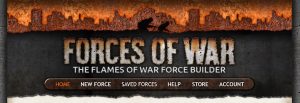
Welcome to the Bagration: German Live Launch
It’s time for the Bagration: German Live Launch! Join us over the next 12 hours as we upload articles and videos all about the latest Flames Of War Late War book as we take a look at the German forces on the Eastern front of WWII.
Be sure to tune in for for Wayne’s Live Q&A on Twitch where he will be answering questions you’ve sent to us and those that you send in over the Twitch chat!
Bagration: Germany Live Launch
Join Battlefront on Sunday 21st March 08:00 AM PST/ 03:00 PM GMT as we launch our new Bagration: German range. We will be updating the Live Launch website with articles and videos and we will streaming from the Battlefront Studio in NZ on our Twitch channel as Wayne doe a Live Q&A. Be sure to join us there!
Click here to go to the Live Launch Website…
Be sure to follow us on Twitch to get notified when we go live…

